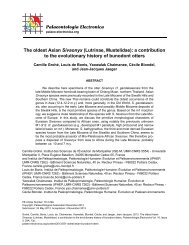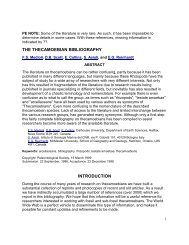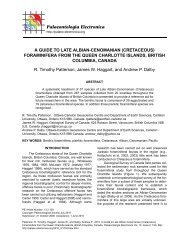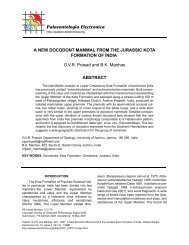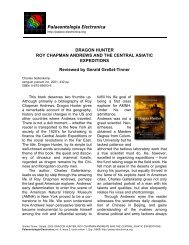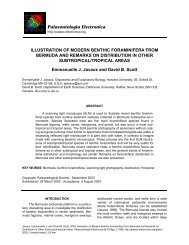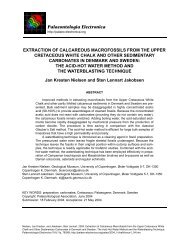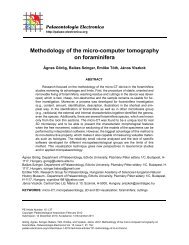Appendicular skeleton and dermal armour of the Late Cretaceous ...
Appendicular skeleton and dermal armour of the Late Cretaceous ...
Appendicular skeleton and dermal armour of the Late Cretaceous ...
You also want an ePaper? Increase the reach of your titles
YUMPU automatically turns print PDFs into web optimized ePapers that Google loves.
PALAEO-ELECTRONICA.ORG<br />
1296, 1490). L. astibiae has a more lateromedially<br />
compressed proximal end, <strong>and</strong> <strong>the</strong> fossa between<br />
<strong>the</strong> anterior <strong>and</strong> anterolateral process is deeper<br />
<strong>and</strong> narrower than that in <strong>the</strong> o<strong>the</strong>r European titanosaurs.<br />
The olecranon process is more prominent<br />
in L. cf. astibiae than in L. astibiae (Company et al.,<br />
2009).<br />
Pelvic girdle<br />
Besides Lirainosaurus, only Ampelosaurus<br />
<strong>and</strong> Paludititan preserve pelvic elements. The ilia<br />
<strong>of</strong> L. astibiae are anteroposteriorly more concave<br />
above <strong>the</strong> acetabulum than in <strong>the</strong> specimen <strong>of</strong> P.<br />
nalatzensis; <strong>the</strong> pubic peduncles are robust <strong>and</strong><br />
anteroventrally oriented in both taxa. Only L.<br />
astibiae presents a triangular hollow at <strong>the</strong> base <strong>of</strong><br />
<strong>the</strong> pubic peduncle <strong>of</strong> <strong>the</strong> ilium, as in <strong>the</strong> Argentinean<br />
saltasaurine Rocasaurus muniozi (Salgado<br />
<strong>and</strong> Azpilicueta, 2000; V.D.D., personal observation),<br />
but it is also present as a presumable convergence<br />
in <strong>the</strong> basal eusauropod Cetiosaurus<br />
(Upchurch <strong>and</strong> Martin, 2003 fig. 11A, B).<br />
Damage to <strong>the</strong> pubis <strong>of</strong> L. astibiae makes<br />
comparison with A. atacis <strong>and</strong> P. nalatzensis difficult.<br />
However, <strong>the</strong> obturator foramen seems to be<br />
larger <strong>and</strong> more dorsally located in <strong>the</strong> pubis <strong>of</strong> L.<br />
astibiae.<br />
Hindlimb<br />
Hindlimb bones are known for all <strong>the</strong> European<br />
titanosaurian taxa. All <strong>of</strong> <strong>the</strong>m except A.<br />
velauciensis preserve femora, which are anteroposteriorly<br />
compressed <strong>and</strong> have a straight diaphysis.<br />
They also show a lateral bulge <strong>and</strong>, just above<br />
it, <strong>the</strong> proximolateral margin is medial to <strong>the</strong> lateral<br />
margin <strong>of</strong> <strong>the</strong> distal half <strong>of</strong> <strong>the</strong> shaft – as in most<br />
Titanosauriformes (Wilson, 2002; Upchurch et al.,<br />
2004; Mannion et al., 2013) – but in <strong>the</strong> Romanian<br />
titanosaurs this feature cannot be observed due to<br />
<strong>the</strong> preservation <strong>of</strong> <strong>the</strong> specimen (NHMUK R.<br />
3849). The femora <strong>of</strong> L. astibiae <strong>and</strong> L. cf. astibiae<br />
are more slender than those <strong>of</strong> A. atacis. The femoral<br />
head is dorsomedially directed, <strong>and</strong> <strong>the</strong> fourth<br />
trochanter is reduced <strong>and</strong> posteromedially placed<br />
in <strong>the</strong> diaphysis in all <strong>of</strong> <strong>the</strong>m. In <strong>the</strong> upper third <strong>of</strong><br />
<strong>the</strong> posterior surface <strong>of</strong> <strong>the</strong> femoral shaft <strong>of</strong> L.<br />
astibiae, <strong>the</strong> greater trochanter extends distally like<br />
a flange. This flange, or trochanteric shelf, is also<br />
present in <strong>the</strong> titanosaurs Saltasaurus loricatus,<br />
Neuquensaurus australis, Rocasaurus muniozi,<br />
Rapetosaurus krausei <strong>and</strong> Jainosaurus cf. septentrionalis,<br />
but also in more basal somphospondylans<br />
too (Curry Rogers, 2009; Wilson et al., 2011; Mannion<br />
et al., 2013; V.D.D., personal observation).<br />
The distal condyles are more medially directed in<br />
<strong>the</strong> Spanish specimens than in A. atacis. Vila et al.<br />
(2012) studied several femora assigned to titanosaurs<br />
from upper Campanian to uppermost Maastrichtian<br />
fossil-sites <strong>of</strong> Spain <strong>and</strong> Sou<strong>the</strong>rn France,<br />
referring <strong>the</strong>m to different types according to a set<br />
<strong>of</strong> anatomical features. One <strong>of</strong> <strong>the</strong> types comprises<br />
two specimens from Fox-Amphoux <strong>and</strong> probably<br />
three more femora from Bellevue (Campagne-sur-<br />
Aude). This material has been referred to cf.<br />
Lirainosaurus astibiae, because <strong>of</strong> its ECC <strong>of</strong><br />
about 2 (200%), <strong>the</strong> scarcely developed, ridgeshaped<br />
fourth trochanter, <strong>and</strong> <strong>the</strong> anteroposteriorly<br />
compressed distal end with medially directed distal<br />
condyles. However, <strong>the</strong>se French femora do not<br />
share with Lirainosaurus astibiae <strong>the</strong> following features:<br />
Lirainosaurus presents an RI <strong>of</strong> about 0.2,<br />
whereas <strong>the</strong> French femora exhibit an RI <strong>of</strong> almost<br />
0.16; in <strong>the</strong> French femora <strong>the</strong> lateral bulge is anteriorly<br />
projected in anterior <strong>and</strong> lateral views,<br />
whereas in Lirainosaurus it is straight; Lirainosaurus<br />
presents a trochanteric shelf in posterior view;<br />
<strong>and</strong> <strong>the</strong> intercondylar sulcus is much more developed<br />
in Lirainosaurus than in <strong>the</strong> French specimens.<br />
Also, Vila et al. (2012) noted that <strong>the</strong> femora<br />
assigned to cf. Lirainosaurus astibiae are morphologically<br />
similar to those <strong>the</strong>y had assigned to<br />
Ampelosaurus atacis, differentiating <strong>the</strong>m only in<br />
<strong>the</strong> proximodistal development <strong>of</strong> <strong>the</strong> lateral bulge<br />
<strong>and</strong> <strong>the</strong> position <strong>of</strong> its distalmost edge. This highlights<br />
<strong>the</strong> need for particular care in attributing isolated<br />
femora <strong>of</strong> this type to Lirainosaurus.<br />
All <strong>the</strong> Ibero-Armorican taxa are represented<br />
by tibiae M. dacus preserves a distal fragment <strong>of</strong><br />
a tibial diaphysis (NHMUK R. 3850) <strong>and</strong> <strong>the</strong>se<br />
are very similar. The tibiae <strong>of</strong> Ampelosaurus <strong>and</strong><br />
Atsinganosaurus seem to be more robust than<br />
those <strong>of</strong> Lirainosaurus (except for <strong>the</strong> right tibia<br />
MDE C3-1303 <strong>of</strong> A. atacis, which is more gracile).<br />
A. velauciensis <strong>and</strong> NHMUK R. 3850 also have a<br />
prominent anteromedial ridge close to <strong>the</strong> distal<br />
extremity <strong>of</strong> <strong>the</strong> tibia delimiting two concave surfaces.<br />
All <strong>of</strong> <strong>the</strong>m show a distal end whose transverse<br />
diameter is longer than <strong>the</strong> anteroposterior<br />
one except Lirainosaurus astibiae, whose distal<br />
end is more subquadrangular. This feature is probably<br />
a diagnostic character <strong>of</strong> <strong>the</strong> Iberian taxon.<br />
Only L. astibiae <strong>and</strong> A. atacis preserve complete<br />
fibulae (M. dacus preserves some fragments<br />
<strong>of</strong> <strong>the</strong> diaphysis). The main difference between <strong>the</strong><br />
two taxa is that <strong>the</strong> proximal <strong>and</strong> distal extremities<br />
<strong>of</strong> <strong>the</strong> tibiae <strong>of</strong> A. atacis are more exp<strong>and</strong>ed than<br />
those <strong>of</strong> L. astibiae. Also, L. astibiae does not present<br />
a sigmoidal ridge associated with <strong>the</strong> lateral<br />
13



